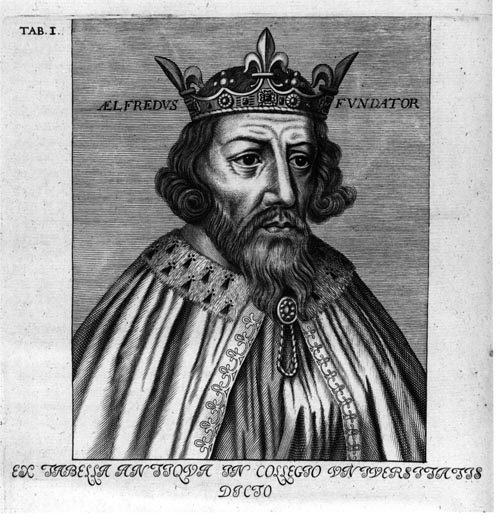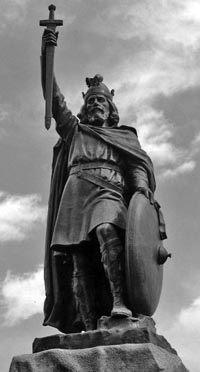As a nation we have our heroes, though we can often be coy about celebrating them. Workers looks at the life of a man who laid the basis for England – and for Britain…
Alfred the Great and the foundation of England
WORKERS, NOVEMBER 2009 ISSUE
Alfred the Great was crucial to England’s development, not just in the military field but also for his remarkable social and political contributions. He earns his standing as one of the greats in history as a result of his outstanding role in the formation and unification of England, his essential role in the expulsion of the Vikings and his extraordinary achievements in developing culture and an educational style of kingship.
Militarily, he was an innovative military leader who radically transformed the situation of Wessex (the Anglo-Saxon kingdom in south-west England) and England itself, sending it in a new direction. A central feature of his military greatness resided in his courage and inspiration to others, best illustrated in the seemingly hopeless circumstance of 878 (see below).
Alfred was able to turn the tide in his people’s favour, even though he saw his land of Wessex – England’s most powerful kingdom – almost completely destroyed in the space of only a few weeks by Viking invaders, his country being reduced in size to the tiny Isle of Athelney. However, he refused to succumb and led initially a very small, brave group of Anglo-Saxons who struck out relentlessly and tirelessly against the dominant Vikings in five weeks of guerrilla-style raids in order to transform this near ruinous situation.
In the wilderness
Alfred exercised a special role during his strange sojourn in the wilderness when, though rejected by all around him, he decided to fight back. In the process he set in train a revolution that would lead eventually to the foundation of England and colour much of what it would later become.

|
| Alfred the Great: an engraving made in the 16th century. |
After the guerrilla raids, Alfred called together the three fyrds (the Anglo-Saxon militia) of Hampshire, Somerset and Wiltshire to battle; they answered loyally and he placed an army of perhaps 4,000 men against Guthrum’s Vikings in the battle of Edington in 878 which was a complete triumph, forcing Guthrum to accept Wessex domination. He eventually withdrew to East Anglia. Alfred had emerged from near-disaster to leave his descendants a completely altered, favourable situation.
Alfred learned essential lessons from experience, particularly from defeats, thereby making his military expertise the best in both defensive and mobile warfare. Apart from the battle of Ashdown, his early encounters with the Viking/Danish forces were unsuccessful.
He soon realised that his military machine was old-fashioned, consisting of a largely peasant army that could not compete with the highly mobile Viking war bands overwhelming his country. Therefore, he remodelled the national defences, introducing new methods of defending his territories, not just restoring existing ones.
That Wessex did not go the way of the other Anglo-Saxon states of East Anglia, Northumbria and Mercia is largely down to him, as he evolved a series of strategies to change the balance of forces, all of which worked to prevent the Vikings’ highly mobile forces dominating their land, rivers and adjoining seas.
During the military campaigns of 871 to 878, it had been the Vikings who were in strategic control, seizing and often fortifying defensible sites. Learning from the humiliation of being reduced to just the Isle of Athelney and following the decisive defeat of the Vikings at Edington, Alfred systematically created from 880 a chain of defensive fortifications, an organised network comprising 33 fortified burhs (fortified communities, the origin of boroughs) each located within 20 miles of another.
They deliberately obstructed the navigation of rivers with fortified bridges and towns to prevent Viking advances. The garrisons provided a staggering total of 27,671 men out of a population of perhaps just half a million. Alfred’s buhr network worked and had a devastating impact on the Vikings’ ability to conduct mobile warfare by land or by river.
When the wars of 893 to 896 are compared with the desperate struggles of the 870s, a clear difference appears. By the 890s the Vikings were unable to penetrate into Wessex like their predecessors in the 860s and 870s who had moved freely not only up and down eastern England but on three occasions well into Wessex.
But in the 890s the Danes’ army did not penetrate Wessex. The fortified towns were not merely defensive but had offensive purposes, allowing mounted forces based within the garrisons to pursue Viking raiders in their locality and ensuring that large enough forces could be brought to bear upon any threat. In addition, Alfred reorganised the army so that a part of the total was under arms in case of attack, while the rest were working on the land; each part took their turn.
Also, Alfred introduced a greater mobility into the Anglo-Saxon army, which had been lacking previously; by the wars of 893 and 895 his army pursued the Danes in a wide range of movements and with a mounted force.
Although it is doubtful that Alfred was actually responsible for the creation of an English navy, he did introduce new ways of fighting at sea. He appears to be the first English ruler to organise a national naval defence and have a fleet at his command. He wanted to prevent invading Danish expeditions from disembarking more than 5,000 fighting men at any one of a score of undefended ports, as they had been wont to do. He wanted to disrupt their power at sea and stop their harassment of the Wessex coast.
He created a small, defensive fleet, built to his own design, with ships twice as long as those of the enemy, allowing commanding numbers of fighters on board. As they were to serve in home waters, they could be bigger than the Viking boats which had to have a “one-piece” keel necessary for deep-water sailing. Alfred’s ships could carry a larger complement of fighting men. By 885 his fleet was able to confront a Viking fleet and capture 16 of its warships.
Alfred’s policy was to find his enemies at sea before they could start their attack. Therefore he had ships built that were of a size, speed and superior design that could bring them quickly to danger and give an advantage to his fighting men. Towards the end of his reign his ships were not only larger but also higher than the Danish ones and had more oars. Taken together, Alfred’s military approaches changed how the Saxons fought.

|
| Statue of Alfred the Great in Winchester, Hampshire. |
Alfred’s major achievement was that he began the process of uniting Anglo-Saxon England, when it appeared that Saxon society might be completely overrun. He respected the traditions of other Saxon kingdoms, shown most clearly with Wessex’s besieging and conquest of London in 886. Alfred occupied London and all the English people that were not under subjection to the Danes submitted to him.
Though he restored the old Roman defences and built a new city within, he then handed control of London back into Mercian hands, displaying a great deal of political sensitivity but making it abundantly clear who was in charge. For the next generation Mercia continued to be a loyal ally and in effect a province of Wessex. Alfred did not actually complete the unity of Anglo-Saxon England (a feat that fell to his son and successors), but by the end of his reign his achievements had created the first signs of English national consciousness and a rapid increase of Anglo-Saxon power under the leadership of Wessex.
Alongside his military efforts, Alfred created totally new forms of kingship, especially for his time: for him, reviving learning was just as important as building burhs. He was an unusual king because he was an enlightened cultural influence at a time when kings often were not interested in such matters.
In many ways it was what Alfred achieved after his military victory which raises him out of the ordinary. He overhauled procedures of government, but most remarkably he initiated a scheme for the encouragement of learning and involved himself personally in its implementation. He translated important works into the vernacular from Latin and wrote and sponsored books – in so doing, says Melvyn Bragg, he saved the English language from possible extinction.
Knowledge matters
Alfred set up court schools to ensure that future generations of priests and administrators would be better trained. He had a conviction that a life without knowledge or reflection was unworthy of respect. He was determined to bring the thought of the past within the range of his people’s understanding. He insisted those who held positions of authority become literate, just as he had overcome the illiteracy of his youth.
Alfred personally wrote translations of Gregory, Boethius and Augustine. He also ordered the compilation of the Anglo Saxon Chronicle in order to weld together and inspire his people. And as no king had codified the law for about a hundred years, Alfred drew up his law-code in the late 880s or early 890s. This also respected Mercian and Kentish traditions for a number of unifying reasons, strengthening the ties of the nation and binding the country together.
Alfred, as the youngest of five brothers, would in normal circumstances not been have expected to become king; perhaps this destiny spurred him on with a high duty to save the Saxons. It is one thing to win a war, another matter entirely to use the peace constructively.
“In a world falling into ruins he had the courage to plan for a happier future; not only to plan defence, but to plan for a fuller and richer life for his subjects. In this there is something heroic. The achievement is impressive; the vision astonishing,” wrote historian Christopher Brooke. We could learn today from Alfred’s tenacity and ingenuity.